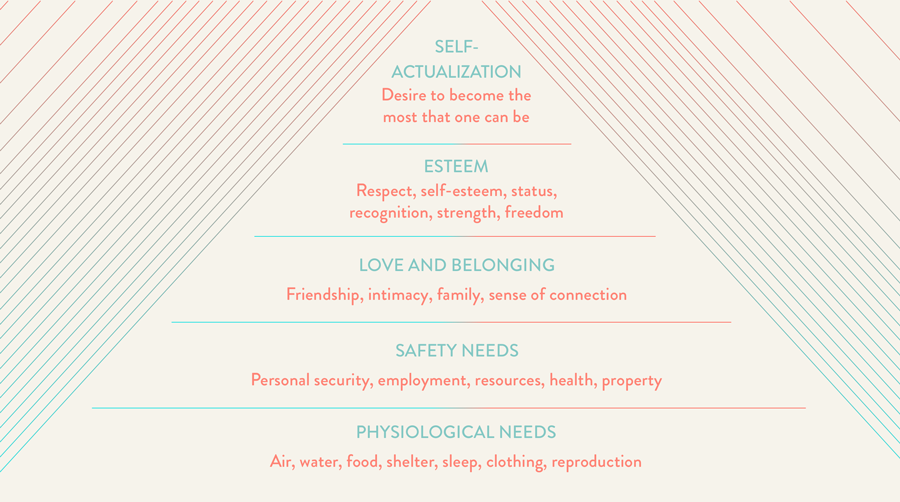Maslow's Hierarchy of Needs: Not Your Traditional Pyramid

Abraham Maslow’s theory of the hierarchy of needs was introduced in his groundbreaking 1943 paper “A Theory of Human Motivation”. Despite the now ancient date of publication, the theories of the American psychologist continue to be widely adopted as an explanation for human motivation and personality, embodied in the quest for goal fulfillment.
The quick and dirty explanation of the hierarchy is that human motivation moves up a ladder; from the bottom of the pyramid to the top. Our most basic needs are physiological, like the need for food, water, and air. Until those needs are completely satisfied, we can’t even begin to think about our next tier of needs. We are totally obsessed with them, even more obsessed than Drake is with the Toronto Raptors.
We move our way up the ladder, meeting each need until we reach the top, which is self-actualization, or in other words, being the person that we are meant to be.
Thankfully, this is not the type of pyramid scheme that will seem pretty good at first, promising you financial success before forcing you into the situation of pitching a cosmetics sales plan to your boyfriend’s cousin at her own wedding.
Nope, this is just a regular old psychological theory that might explain some of your behaviors and help you differentiate between healthy and unhealthy manifestations of desire.
Digging into the pyramid like you’re trying to expose the Illuminati
Forget the Illuminati and the Eye of Providence, the real way to get woke is through self-betterment and psychologist Abraham Maslow’s hierarchy!
Maslow was born into hard-scrabble Brooklyn on April 1, 1908. His parents, Ukrainian Jews fleeing antisemitic violence, did everything they could to get him a good education. He got one—doing his undergrad at City College New York, and obtaining a Master's in experimental-behaviorist psychology from University of Wisconsin, Madison.
He was a good-enough student and academic, but his research was not yet anything close to visionary. But all that changed during the dark days of World War II.
As he went about his business teaching at Brooklyn College, he began research into the concept of self-actualization, spurred by a vision of a better world where people's motiviations are channeled into productive, rather than destructive pursuits. He was assisted by Max Wertheimer, the Gestalt psychologist who emphazised higher order cognitive processes, and Ruth Benedict, a holistic anthropologist and the author of Patterns of Culture (1934), which addressed the interplay of human culture and the individual.
Another one of his major influences was Sigmund Freud's contemporary Alfred Adler, the 'social idealist' who founded the school of individual psychology. Adler moved away from Freudian supression of libidinal/aggressive tendencies towards a perspective favoring more permissive, sunny, and co-operative outcomes.
Halfway through America's involvement in the war, in 1943, Maslow's paper was published, and the field of humanistic psychology was up and running.
Maslow was not the sole founder of humanistic psychology, Carl Rogers, Rollo May, and James Bugental were also instrumental figures, but he was probably the most successful of the bunch with regards to infiltrating the cultural mainstream.
His theory of hierarchy was initially applied in business theory to underline the idea that traditional structures would not fulfill employees psychologically, and might lead to increasing unhappiness and lowered productivity in the workforce. If everyone is hangry, then who’s going to crank out that powerpoint at 12:23?
These theories were one of the major launching points for the whole “let’s treat our employees like living, breathing humans instead of human-shaped piles of garbage” theory of management.
For example, in its literal form, the need for safety might be described as the desire to not sleep outside in the middle of a snowstorm for a week in just your underwear, or, not getting run over by a truck filled with murderous clowns. Not feeling safe will grievously impact your mental health as well.
And, if you are constantly stressed about being run over by a truck of clowns, then you probably won’t have any spare mental energy to consider loftier theoretical needs like self-fulfillment.
Ultimately, Maslow asserts that humans are constantly wanting, and that very few people manage to reach the top tier of human potential, the 'peak experiences' at the apex of the pyramid. However, the journey towards self-actualization itself can be beneficial to our wellness.
The exercise of defining and fulfilling our needs, and progressing towards fulfilling our personal destinies, are integral parts of living a happy and healthy life.
So what is self-actualization exactly? As Maslow states in his 1942 article “A Theory of Human Motivation”:
“A musician must make music, an artist must paint, a poet must write, if he is to be ultimately happy. What a man can be, he must be. This need we may call self-actualization. It refers to the desire for self-fulfillment, namely, to the tendency for him to become actualized in what he is potentially. This tendency might be phrased as the desire to become more and more what one is, to become everything that one is capable of becoming.”
In other words, if Maslow’s hierarchy is Destiny’s Child, then self-actualization is Beyonce.
The other members are pretty important, pretty cool, have pretty good voices. But no matter how much space they take up, no matter how important they might seem—they aren’t Beyonce. She just has that something extra.
On the other hand, Beyonce couldn’t have experienced her meteoric rise to the top without classic Destiny’s Child tracks like “Say My Name.”
Could you imagine your middle-aged mom doing fitness classes if “Bootylicious” had never been created? Well, maybe you can. The point is: Beyonce wouldn’t be where she is today without Destiny’s Child, just as the top of Maslow’s pyramid would be nowhere without its base.
Cure your anxiety without quitting your job and moving to Berlin to become a DJ
Despite writing his theories in the 1940s, Maslow had some pretty interesting insights into the problems of anxiety and social expectations that bothers so much of society today:
“The neurosis in which the search for safety takes its dearest form is in the compulsive-obsessive neurosis. Compulsive-obsessives try frantically to order and stabilize the world so that no unmanageable, unexpected or unfamiliar dangers will ever appear; They try to arrange the world so that anything unexpected (dangers) cannot possibly occur. If, through no fault of their own, something unexpected does occur, they go into a panic reaction as if this unexpected occurrence constituted a grave danger.”
If you are consistently and compulsively worrying about fulfilling any of the tiers of the hierarchy, you will sink into the millennial plague known as anxiety.
Modern anxiety comes from many places—but a key one is a self-imposed expectation of fulfillment.
People are constantly wanting more—more success, more money, more stability, more happiness—and all of those things can become overwhelming, especially when combined together into a big, scary dark cloud hanging over our brains.
The key seems to be adapting the goals outlined by Maslow to make them more manageable.
We need to spend the necessary energy required to fulfill each of the different tiers of Maslow’s pyramid. Favoring or neglecting one tier or another will result in certain aspects of your life suffering accordingly.
Maslow states:
“If all the needs are unsatisfied, and the organism is then dominated by the physiological needs, all other needs may become simply non-existent or be pushed into the background. The receptors and effectors, the intelligence, memory, habits, all may now be defined simply as hunger-gratifying tools. The urge to write poetry, the desire to acquire an automobile, the interest in American history, the desire for a new pair of shoes are, in the extreme case, forgotten or become of secondary importance.”
Or, in the words of your little brother after he learned about Maslow’s hierarchy theory:
“Bro, I know you want to keep fantasizing about that new pair of Air Jordans—so make sure you eat a nice healthy lunch and make sure things are going well with your partner, OK?”
Maslow’s critics
There are a lot of articles that criticize Maslow because he is not modern enough, or does not account for the evolution of social interaction as a driving force—but a lot of these criticisms do not take the time to adequately understand Maslow’s theories.
For example, Forbes states that the hierarchy, “offered an unrealistic route to meeting those needs: ascension up the hierarchy of needs towards self-actualization. The truth is that not everyone wants or needs or is able to be a self-actualizing artist or leader.”
Maslow does not assert that everyone, in their quest for self-actualization, is seeking to become an ‘artist’ or ‘leader’—rather, that everyone seeks to become the most potent version of themselves possible, WHATEVER that may be.
Taking Maslow’s hierarchy too literally can lead to a self-imposed pressure to constantly be striving for the theoretical top—when in reality, compartmentalizing things and taking them step-by-step can be a much more effective way to making progress towards a happy and healthy life—and to avoid all of those pitfalls of anxiety along the way.
Don’t put your idealized self on an unreachable pedestal!
Maslow’s self-actualization and hierarchy of needs, in general, exists on a scale that can evolve and transform with each person’s development. As our life changes, so do our aspirations. Your goal 5 years ago, which may have been to get a raise at your kitchen job, won’t necessarily be relevant today if, for example, you left that job and now work as a teacher.
If, in your current position, your mind envisions itself as being a pretty good, but not the-best-in-the-city graphic designer, then perhaps a form of self-actualization can be achieved by holding down a steady, decently paying design job at a local firm.
While Maslow felt that many people did not manage to reach self-actualization, technically if your mind has set a goal, and attained that goal through the fulfillment of your personal needs, then, in theory, have you not achieved self-actualization?
In turn, as you gain experience, maybe a little personal brand here, a little specialization there, perhaps the goalposts of self-actualization might shift to becoming the best damn graphic designer in the country.
As your end goal of self-actualization increases in scope, the other levels of your pyramid could simultaneously transform. We’re talking about transforming pyramids now, so you know this is deep!
As your ultimate goal for self-actualization shifts, the pre-requisites for your pyramid level of self-fulfillment, or of safety, might also change to match the new end-goal: when you were a lowly scrub at the bottom of the corporate ladder, receiving a bi-weekly paycheck just to be able to buy a single movie ticket and a Tim Horton’s coffee may have been enough to satisfy your requirements of safety, love, and self-esteem—but now, your priorities have shifted, and earning the respect of your colleagues or living in a fulfilling relationship are more important than having ten bucks in your pocket.
All that to say, Maslow’s theories need to be paired with continuous self-assessment and self-work in order to be aware of and to fulfill one’s needs.
How will you recognize that your needs have shifted and how will you fulfill the new requirements if you do not take the time to assess them?
Self-awareness is the foundation of self-improvement—it’s the starting point for everything!
Some revamping of Maslow’s concepts
The difficulty with Maslow’s hierarchy model is its rigidity.
We have reached a point in time where opportunities and positions in society can be accessed by a much wider and more diverse grouping of people—therefore, models for success need to be adjusted to account for different people, and for new scales of success.
Even Maslow points to the idea of a progressive scale of fulfillment across different needs; he just doesn’t explain it well enough and it gets slightly lost in the shuffle.
On the other hand, Maslow’s theories have become so widely accepted as a foundation for human motivation that they have themselves become an archetype.
In using a fixed hierarchy to define all of our needs and goals, we are also placing all of our motivations and actions inside of a box. Maslow’s hierarchy omits the possibility of cultural and individual differences having an impact on motivations and needs, and seems to take away the power of individual agency and choice.
We need to look at our own actions, as objectively as possible (try journalling!) to determine which actions contribute positively to our journeys of self-betterment, and how they actually fulfill those different tiers of needs.
This is especially important when you consider that sometimes, the things we are sure that we require might actually be hiding our true psychological needs. As Maslow states:
“...the person who thinks he is hungry may actually be seeking more for comfort, or dependence, than for vitamins or proteins.”
Say, for example, you like to play laser tag every weekend. You’re a fully grown adult, the parents and employees at laser tag think that you’re a weirdo for always hanging around laser tag, but you just like to get in there and prove you’re “da bomb” by blasting teenagers with fake laser beams.
You get unimaginable satisfaction from seeing your name at the top of that leaderboard after every match. You gloat and make fun of all of the pre-teens for being worse at laser tag then you. Maybe you knock their soda out of their hands in the lobby and steal their redeemable tickets so that you can save up and buy yourself a giant stuffed Pikachu.
What motivations are driving this behavior?
According to Maslow, every action, even if not explicitly, is driven by one of the hierarchical levels.
Even if you think that you are just having fun, or blowing off steam, maybe your behavior is actually a cry for safety—destroying pre-teens at laser tag may reinforce your desire for safety by removing the obstacle of a challenge. Or perhaps you are attempting to build up your self-esteem.
Stop, hammer time!
After publishing his article, Maslow was surprised by how many people wrote to him, thanking him for having helped them achieve self-actualization. In reality, when he wrote the article, he suspected that only a very tiny percentage of humanity could ever reach the top of the pyramid.
There is the temptation, in the quest for self-betterment, to imagine a specific end-point and to feel satisfied when you feel like you’ve reached it. But, at the end of the day, self-betterment is a never-ending journey.
You can spend your whole life trying to reach the top, without appreciating that the climb is just as important and rewarding as reaching the peak.
Maslow himself died quite randomly of a heart attack June 8, 1970 while out jogging in Menlo Park, California. He was 62 years old, and had ascended and descended many peaks. His death in 'the valley' of life, doing something everyday, would be but a footnote in the rich story of humanistic journeys that made up his professional life.
All this to say that we aren't here forever, and there is no easy way to reach self-actualization.
Diversity is key. Using every tool and support network at your disposal is essential: journalling, community, love, therapy, meditation, exercise, education—all of these things will make that climb just a little bit easier.
Constantly exposing ourselves to new ideas, experiences, and excitements is one of the best ways to avoid the deepest root cause of anxiety: stagnation. As Maslow states in one of his most famous quotes:
“I suppose it is tempting, if the only tool you have is a hammer, to treat everything as if it were a nail..”(‘Maslow’s Hammer’ — Abraham Maslow, 1966)




